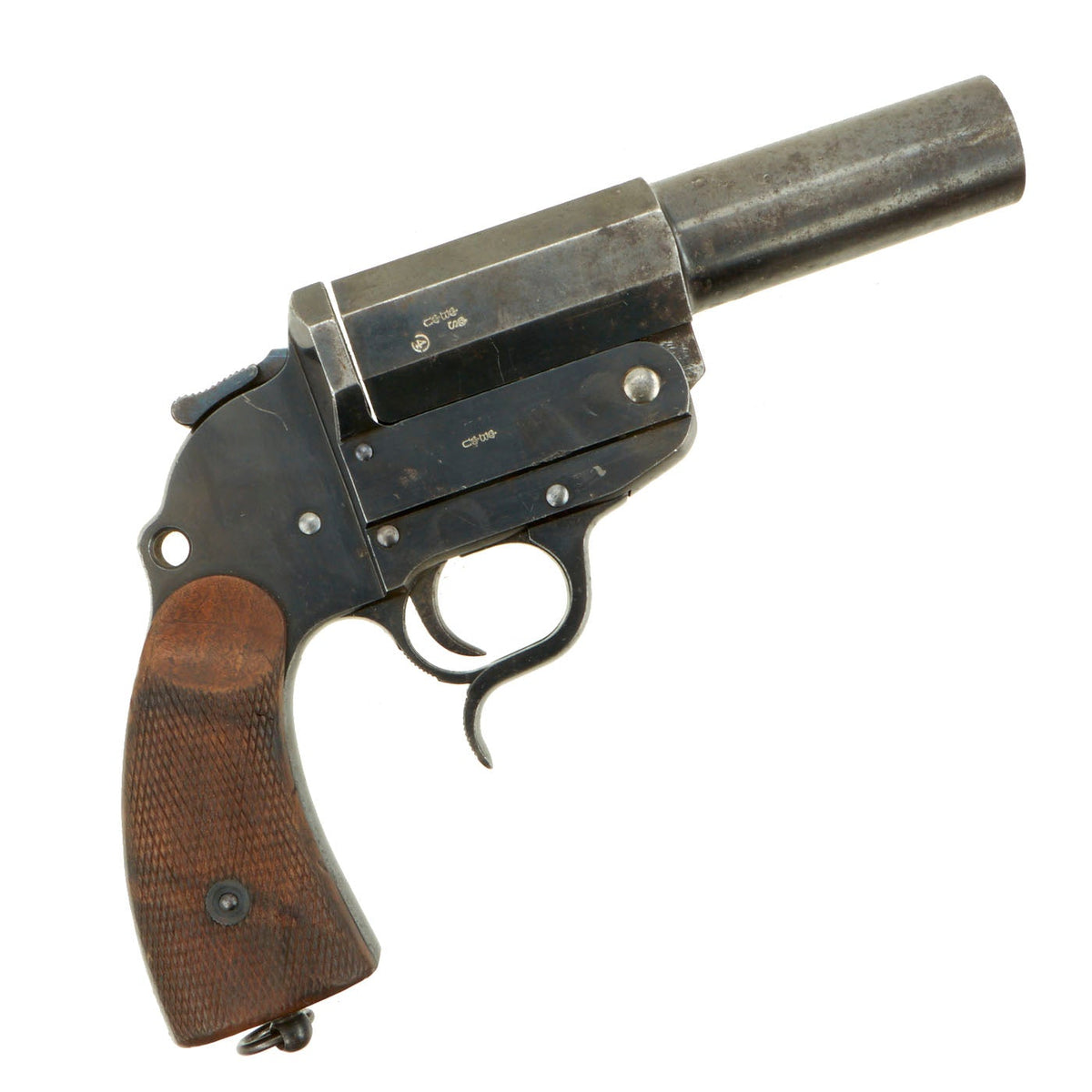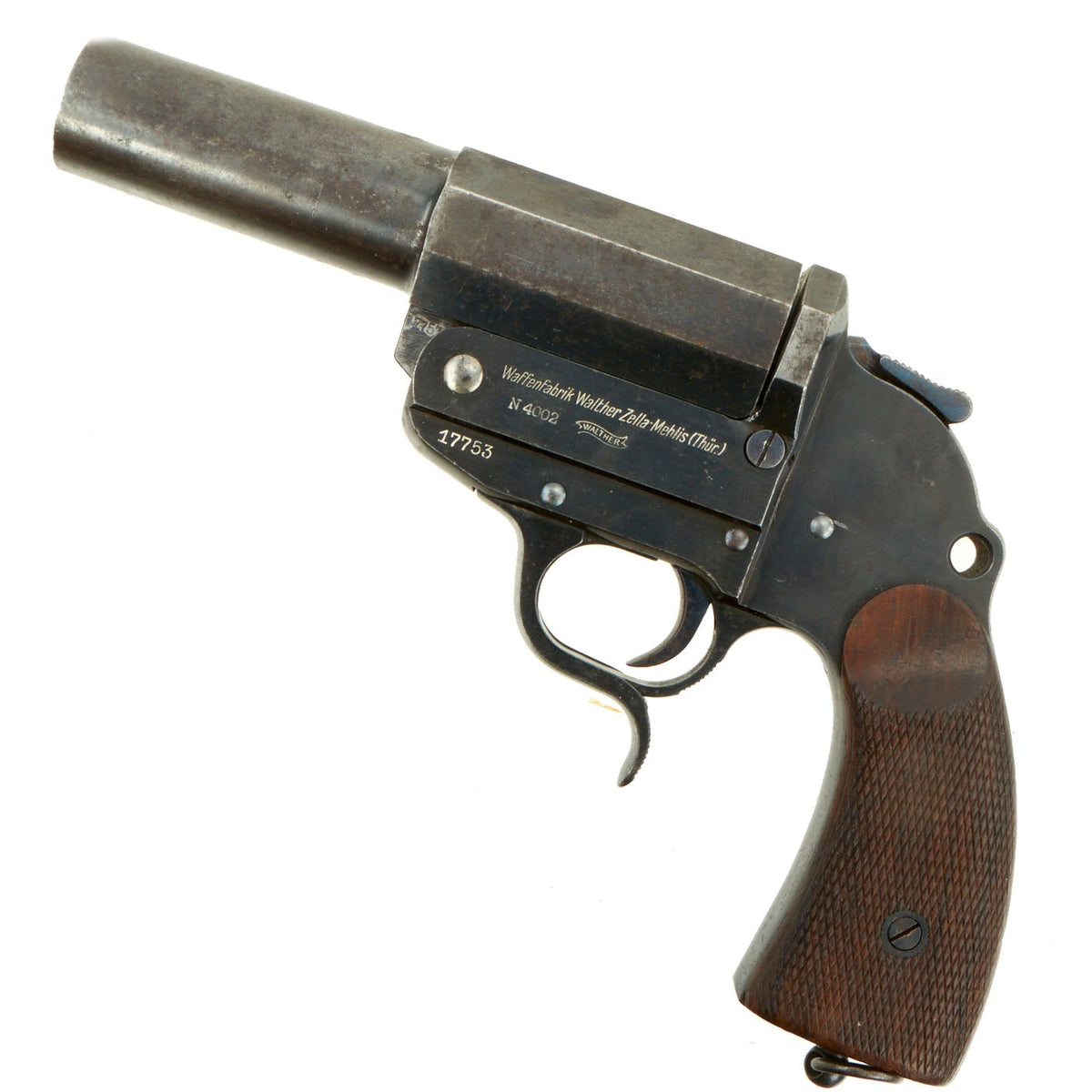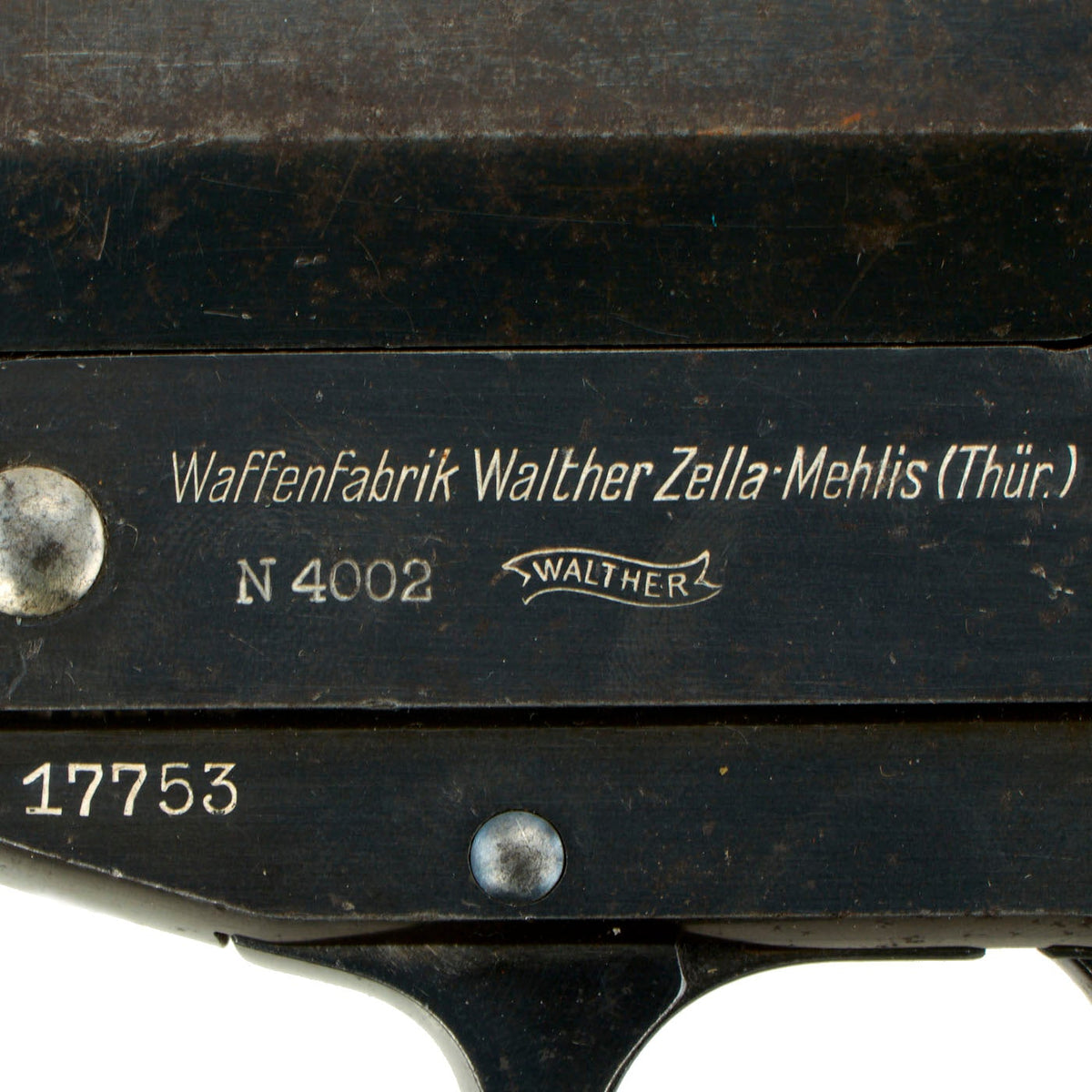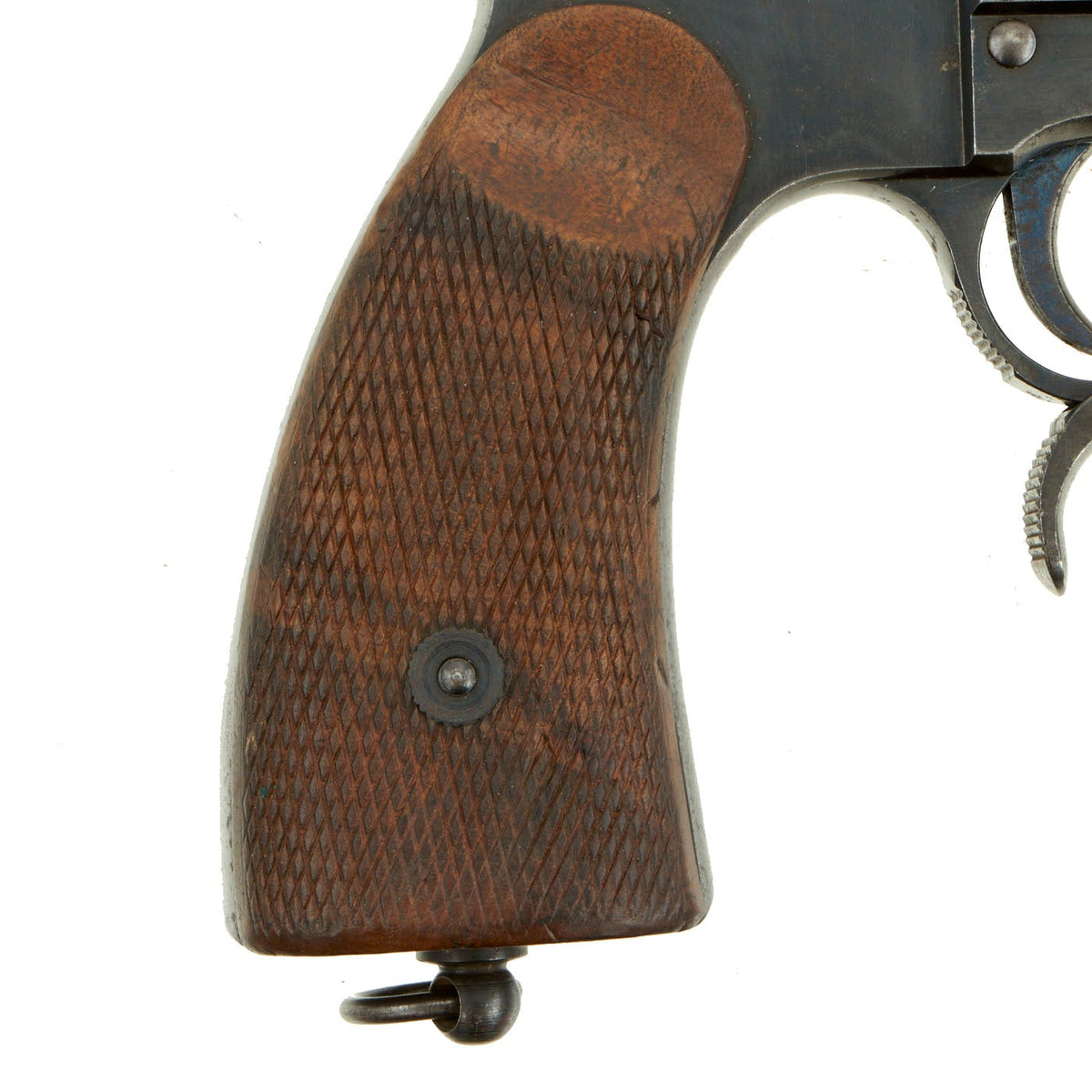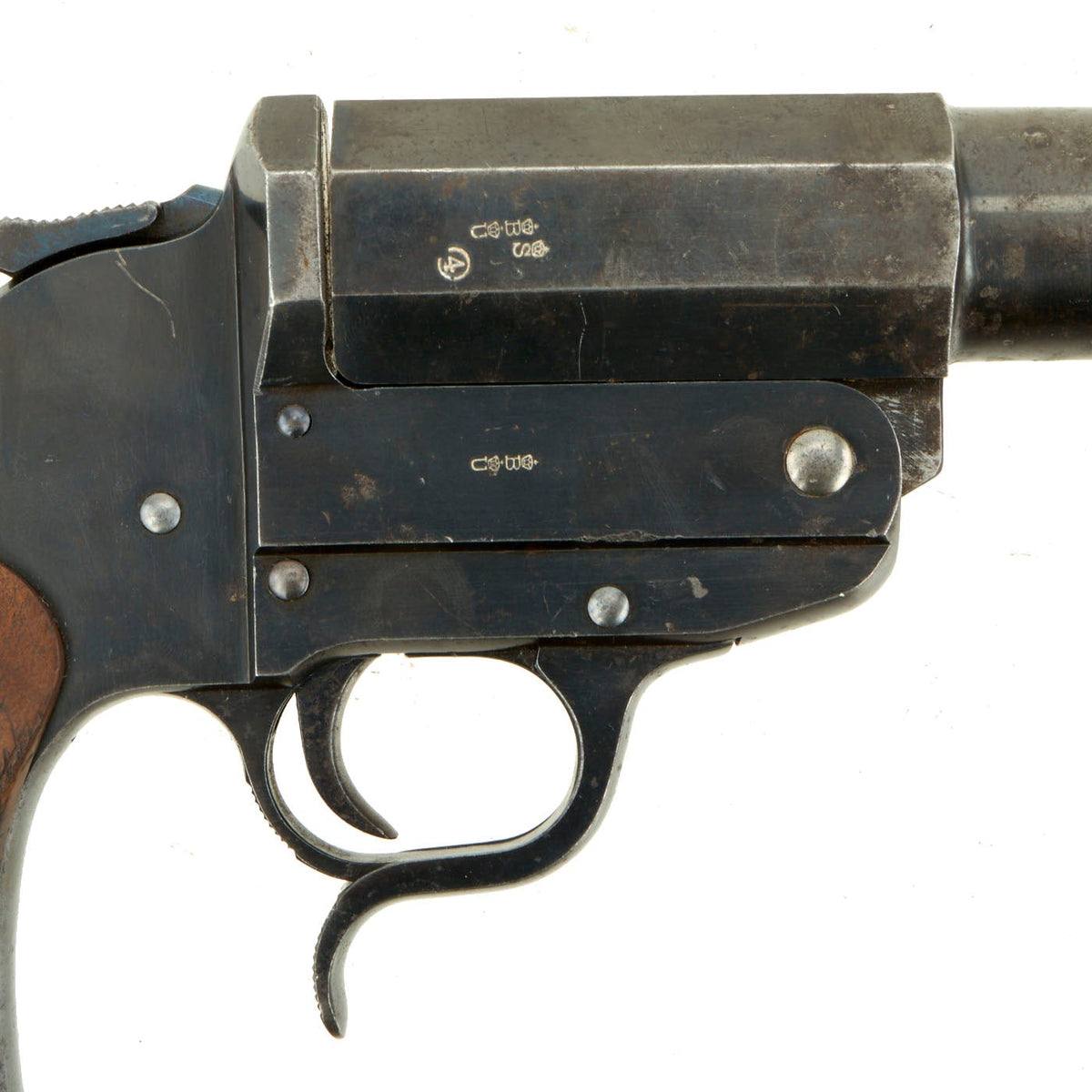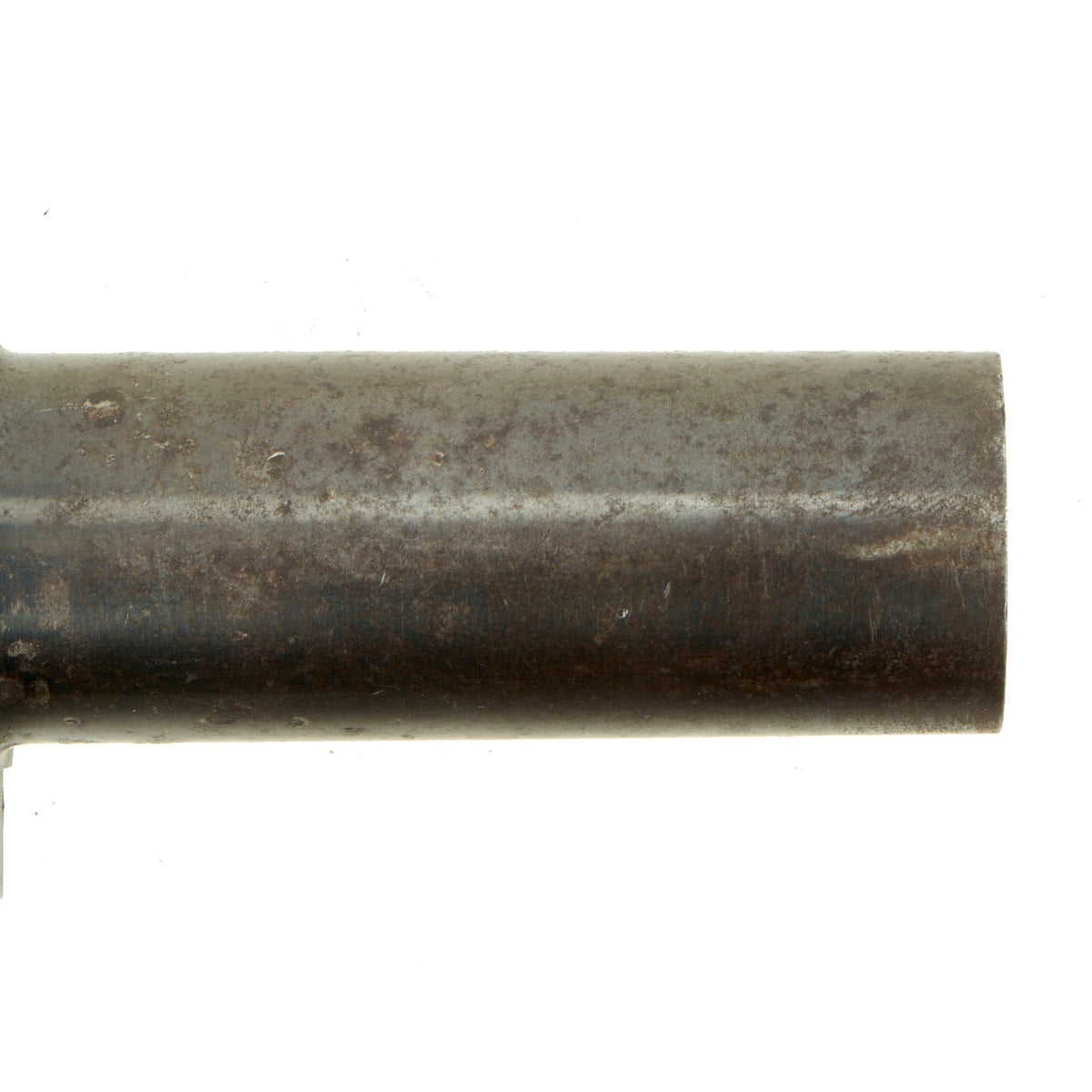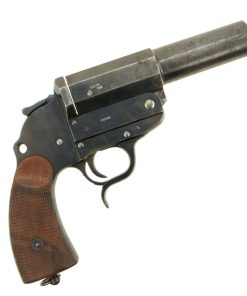Original German Pre-WWII Walther Model 28 Leuchtpistole Serial 17753 – Early LP28 Flare Gun Original Items
$ 1.095,00 $ 273,75
Original Item: Only One Available. This is a first for us at IMA. This is an early Model 28 Leuchtpistole and not a later conversion model. This is of an all steel construction and not aluminum with original wooden checkered grips and the smaller trigger guard. Most of these LP28s went “under the knife” for use in WWII by the Wehrmacht.
As originally produced, this LP28 was made entirely of blued steel, has a set of checkered wood grips, and has a rather small trigger guard. This made for a relatively heavy flare pistol, which was hard to operate with a gloved hand, so changes were made for the next step in flare pistol evolution. ON THE UPGRADED LP28s: The frame and barrel were changed to anodized “Duralumin” alloy, the grips changed to checkered bakelite, and the trigger guard enlarged. The internal mechanism was also simplified, removing the interrupter that prevented the breach from opening when the pistol was not cocked, which also prevented it from being dry fired when the breech was open. The result was the LP34.
This is an “untouched/unupgraded” Walther Model 28 Leuchtpistole. As talked about, this LP28 is made entirely of blued steel with the smaller trigger guard and the checkered wood grips. The serial numbers match on both the receiver and barrel. The serial number is 17753 and can be seen on both pieces. This example has the correct Walther Pre-War “Banner Logo” on the left side of the frame, along with the official name of the factory:
Waffenfabrik Walther Zella-Mehlis (Thür)
N 4002 (Walther)
At the Walther factory individual parts were marked with the acceptance mark WaA359. Until 1939, the test marks on the right side of the barrel consisted of B / S / U under an imperial crown, as well as “4” in a circle for the caliber and normally a spoked wheel, which is not present on this example, believed to symbolize approval of smooth-barrel weapons for the Zella-Mehlis region. The B / U under an imperial crown are repeated on the frame. From 1940 and onwards these are all replaced by an eagle over an upside down heart with a fir tree inside; the civil test approval mark for the region of Zella-Mehlis, Thuringia. The same mark is stamped on both barrel and frame. All stamping is still very clear and able to be easily seen.
This is a very beautiful and seldom seen original and non-upgraded LP28 with matching serial numbers. This was a first for us and we hope to come across another all original LP28 in the future.
Comes ready to display in your Pre-WWII and WWII Wehrmacht collections!
When Fritz Walther constructed the flare gun it was simply called “Leuchtpistole”. However, as time marches on, the veil of history has really complicated matters.
Collectors love to attach names to things and to categorize them, in order to distinguish models or versions from each other when the official name is unknown. The “Hebel” and the “Drückknopf” flare guns are typical collector’s “inventions”
As a flare gun for the commercial market it was called “Walther’s Leuchtpistole” to discern it from competitors, but it was also categorized in brochures as a “Signalpistole”.
The name “Walther-Leuchtpistole” was printed in commercial brochures and advertisements in the 1930s, at least right up to the Geco catalog from 1937 (picture above). Directly translated it becomes “Light (illuminating) pistol”, which refers to the original application area. As the use expanded over the years, it was more and more common to use the “Light pistol” to fire signals. But the word “Signal” was not used by the Wehrmacht to describe the flare gun; it only refers to the ammunition.
Reichswehr had little need to distinguish between models after the “Walther-Leuchtpistole” was acquired in the period 1926-1928, so they simply named it “Leuchtpistole”, abbreviated “LP”. This term was dominant in all military publications until the heir came into use; the “Leuchtpistole 42”, abbreviated “LP42”. In the new release of H.Dv. 409, published on July 1, 1943, the flare gun was referred to as “Leuchtpistole (Model Walther)”, to distinguish between the “old” standardized flare gun and the new LP42. The only case where one needs to distinguish between the new flare gun (Leuchtpistole Model Walther) and the old flare gun (Leuchtpistole Model 1894) is when there is equipment or accessories that is not compatible. In this case, they are referred to as “Leuchtpistole a/A” and “Leuchtpistole n/A”, respectively. “a/A” and “n/A” means old and new version (alter Art and neuer Art).
All “models” of the Walther-Leuchtpistole, with the exception of Leuchtpistole Z, thus have the same designation in the Wehrmacht; “Leuchtpistole” This applies regardless of whether the flare gun has a long barrel, is manufactured in steel, Duralumin or in zinc. One does not distinguish between “editions”, since the differences that occur over time are largely due to improvements or simplifications in the production of parts.
Post-war collectors in need of cataloging and separating «versions» from each other created all the names of the different versions of this flare gun, even though these “versions” were in reality the same product at different stages of a development that lasted from 1926 to 1943. Examples of fictitious collector terms are “M26”, “LP26”, “M34”, “LP34”, “Heer Model 1934”, “Kriegsausführung”, “Ausführung 1943” and “Zink Signalpistole Model Heer”.
In the Wehrmacht supply system, Walther’s flare gun had article number “N4002”, and all parts for the flare gun were numbered in the same series. “4002” is, of course, only a serial number that was used to identify a complete flare gun, but “N” in this context is of interest.
This letter denotes “Nachrichtengerät”, communication equipment, in the Wehrmacht supply system catalogue. In other words, the flare gun was not classified as a weapon, or infantry equipment, but as communication equipment.
The Luftwaffe appears to have been the only branch of the Wehrmacht that engraved the article supply number (N4002) on the left side of the steel frame on early issues of the long barreled Walther flare gun. The engraved number is “bare metal” in contrast to the rest of the frame that was “blued” at the factory. This clearly indicates that the N4002 marking was applied to the frame post-factory.
The Leuchtpistole ran parallel with the production for the commercial market, exports and production to other state and paramilitary organizations. It is relatively easy to distinguish these from one another by the marking. It is also worth noting that initial production for one organization does not necessarily mean that the flare gun did not end up with the other. There is a wide variety of markings, and sometimes a total lack of them.
Walther
From the start of production the flare gun was marked with the text “Waffenfabrik Walther Zella-Mehlis (Thür.)” over the manufacturer’s trademark; a waving banner with the text “WALTHER”. Zella-Mehlis is the city of Thuringia where the factory was located before and during the war. The company was “restarted” in Ulm post war.
In 1943, the production in Duralumin ends a bit into the “a” block, and the production of the frame and barrel resumes in steel in the same serial number series. The highest registered serial number in steel is 2817a. The production of the flare gun in zinc starts in 1943, and appears to be numbered from the start in a separate series.
At the Walther factory individual parts were marked with the acceptance mark WaA359. Until 1939, the test marks on the right side of the barrel consisted of B / S / U under an imperial crown, as well as “4” in a circle for the caliber and a spoked wheel, believed to symbolize approval of smooth-barrel weapons for the Zella-Mehlis region. The B / U under an imperial crown are repeated on the frame. From 1940 and onwards these are all replaced by an eagle over an upside down heart with a fir tree inside; the civil test approval mark for the region of Zella-Mehlis, Thuringia. The same mark is stamped on both barrel and frame. Waffenfabrik Walther also manufactured the Leuchtpistole for the commercial market or for other organizations. These flare guns initially had a five-digit serial number and later went to a five-digit serial number followed by the capital letter “L”.
Flare guns from these deliveries may still have ended up with the other military or paramilitary organizations, but they are usually marked with additional Luftwaffe, Polizei or Kriegsmarine markings. A series of flare guns from Walther was also delivered to the Kriegsmarine without manufacturer markings or year of production at all.
The latest flare guns of this type manufactured by Waffenfabrik Walther were made of zinc with full pre-war marking (banner), five-digit serial number followed by an “L” and with the last type of wood grip plates. Walther’s production for the Wehrmacht was marked the same way throughout the production with the serial number on the barrel just in front of and above the hole for the barrel pin, and on the frame just below the hole for the barrel pin.
Fast Shipping with Professional Packaging
Thanks to our longstanding association with UPS FedEx DHL, and other major international carriers, we are able to provide a range of shipping options. Our warehouse staff is expertly trained and will wrap your products according to our exact and precise specifications. Prior to shipping, your goods will be thoroughly examined and securely secured. We ship to thousands clients each day across multiple countries. This shows how we're dedicated to be the largest retailer on the internet. Warehouses and distribution centres can be located throughout Europe as well as the USA.
Note: Orders with more than one item will be assigned a processing date depending on the item.
Before shipping before shipping, we'll conduct a thorough inspection of the items you have ordered. Today, the majority of orders will be delivered within 48 hours. The delivery time will be between 3-7 days.
Returns
The stock is dynamic and we cannot completely manage it because multiple stakeholders are involved, including our factory and warehouse. So the actual stock may alter at any time. It's possible that you may not receive your order once the order has been made.
Our policy is valid for a period of 30 days. If you don't receive the product within 30 days, we are not able to issue a refund or an exchange.
You can only return an item if it is unused and in the same state as the day you received it. You must have the item in its original packaging.
Related products
Uncategorized
Uncategorized
Uncategorized
Uncategorized
Australian WWII Owen MK1 Machine Carbine SMG Custom Fabricated Replica with Sling Original Items
Uncategorized
Uncategorized
Armoured Fighting Vehicles of the World: AFVs of World War One (Hardcover Book) New Made Items
Uncategorized
Uncategorized
Uncategorized
Uncategorized
Uncategorized
Uncategorized
Angolan Rebel 1970s era 60mm Inert Display Mortar from Angolan Civil War Original Items
Uncategorized
Uncategorized
Uncategorized
Uncategorized
Uncategorized
Uncategorized
